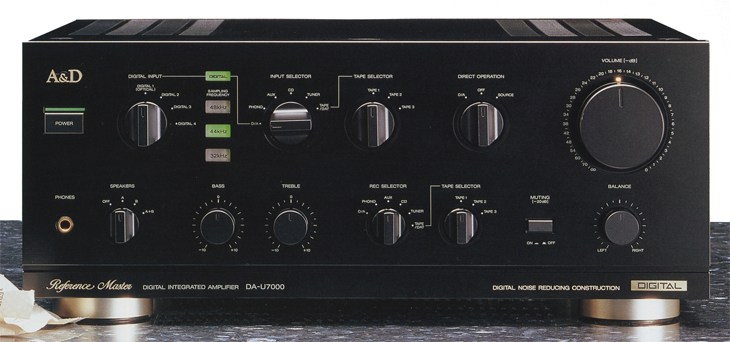
A&D DA-U7000
¥ 89,800 (around 1988)
Commentary
Integrated amplifier with digital input.
As a countermeasure against digital noise, a digital noise reduction structure has been developed and adopted in the DA-U7000.
The digital circuit uses an active PLL circuit.
The input digital signal is demodulated before it is input to the D/A converter and synchronized with the D/A converter. For this purpose, PLL circuits and crystal oscillators are used, but each of them has its own advantages and disadvantages. The PLL circuit is inferior in temperature characteristics and tends to be out of sync when synchronizing in a wide range. Crystal oscillators can achieve accurate synchronization, but on the other hand, they overlap with the oscillation of the PLL and become a powerful digital noise source, which adversely affects the analog section.
The active PLL circuit used in the DA-U7000 uses a crystal oscillator to synchronize with the digital signal first, and after locking, the operation is stopped and the signal is held reliably by the PLL circuit. The PLL circuit is integrated into a single chip together with a voltage control oscillator (VCO) to improve temperature characteristics and reduce unnecessary radiation.
Moreover, when an analog signal is input, unnecessary digital circuits are stopped to prevent excessive digital noise.
The D/A converter is an independent D/A converter for the left and right.
The digital filter is equipped with a 16-bit 4 x oversampling digital filter.
The D/A converter section has a dual shield structure.
In this structure, the circuit is strictly shielded, and the case itself is also floating from the amplifier chassis to shut out external noise from the ground line.
The structure prevents noise from the D/A converter from leaking outside.
In the power supply section, the power supplies for the digital and analog sections are completely separated from the rectifier circuit to the circuit board. In addition, constant-voltage power supplies are arranged independently in a total of 11 locations, including for driving D/A converters and for lighting LEDs, to eliminate interference from digital noise.
The constant voltage power supply uses a reference constant current with a light-emitting diode to produce a constant voltage with less noise and to refine the sound quality.
In the analog amplifier section, the circuit boards of the current amplifier stage (I amplifier) and the voltage amplifier stage (V amplifier) are completely separated, so that the influence of magnetic force due to large current from the I amplifier to the V amplifier is suppressed.
Super active power supply is used for the power supply for the amplifier.
Normally, current is supplied instantaneously from the rectifier diode to the capacitor of the power supply section. However, with the super active power supply, this supply time is approximately three times longer. Moreover, by supplementing this with the DC power supply, a constantly stable, pure and loose constant voltage is supplied from the preamplifier of the amplifier circuit to the drive stage of the power amplifier.
The amplifier circuit is equipped with a new open loop circuit unique to A & D that removes the overall NFB loop.
The open-loop circuit does not have an NFB that returns from output to input. The basic amplifier configuration is simple with only two stages of V and I amplifiers. Each stage is a completely symmetrical cascade non-feedback amplifier, and the bare characteristics are polished to the utmost.
In addition, the input stage of the open loop circuit does not use a general differential input, but adopts a simple circuit configuration of perfectly symmetrical parallel in / push-pull out, and suppresses even order harmonic distortion.
Digital input is equipped with one optical system and coaxial Route 3.
Two coaxial digital outputs are provided.
The sampling frequency is 48 kHz, 44.1 kHz and 32 kHz.
Both digital and analog sources are equipped with independent direct operation switches, and all sources can be connected directly to the power amplifier.
Equipped with a muting switch.
Uses high-quality parts carefully selected in the hearing test.
A large insulator is adopted as a measure against vibration from the outside.
Uses gold-plated terminal.
The power cable is a oxygen-free copper power cable with polarity indication.
Model Rating
| Type | Pre-main amplifier |
| Amplifier Unit | |
| Effective power | 120W + 120W (6 ohm, EIAJ) |
| Output bandwidth | 10 Hz ~ 60 kHz (0.1%) |
| Total harmonic distortion factor | 0.03% (1 kHz, 8 Ω) |
| Frequency characteristic | 3 Hz ~ 100 kHz + 0 -3dB |
| Input Sensitivity / Impedance | Phono MM : 2.0mV/47k Ω CD, Tuner, Tape/DAT, Aux, D/A : 150mV/47k Ω |
| Output Level / Impedance | Tape Rec out : 150mV/1k Ω |
| Damping factor | 30(1kHz) |
| Residual noise | 0.5mV |
| Signal-to-noise ratio (IHF-A) | Phono MM:85dB CD, Tuner, Tape/DAT, Aux, D/A : 100 dB |
| Tone control | Bass : ± 10 dB (100 Hz) Treble : ± 10 dB (10 kHz) |
| Audio Mute | -20dB |
| Suitable speaker impedance | 6 Ω ~ 16 Ω |
| D/A Conversion Unit | |
| Digital sampling frequency | 32 khz, 44.1 khz, 48 khz |
| Digital Input Level / Impedance | Coaxial : 0.5Vp-p/75 Ω Optical : -14 to -23dBm |
| Frequency characteristic | 5 Hz to 20 kHz ± 3 db |
| Dynamic range | 95dB |
| Total harmonic distortion factor | 0.003% |
| Channel separation | 115dB |
| <General> | |
| Power supply voltage | 100 VAC, 50Hz/60Hz |
| Rated power consumption (Electrical Appliance and Material Control Law) | 215W |
| External dimensions | Width 425x Height 177x Depth 452 mm |
| Weight | 16.3kg |
.jpg)
.jpg)
.jpg)
.jpg)